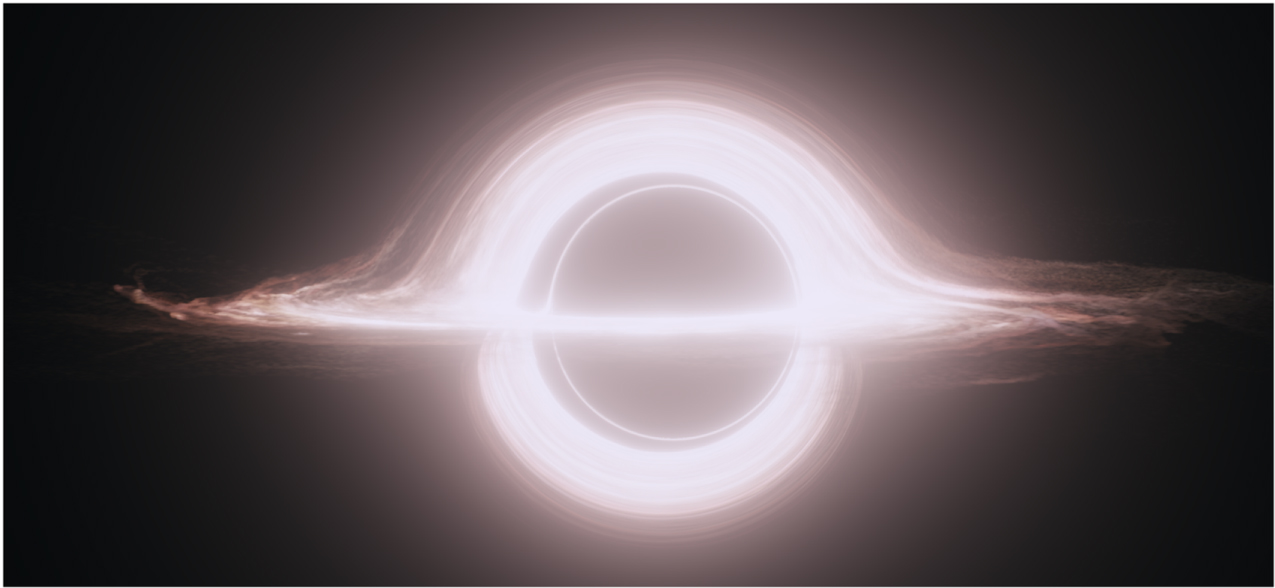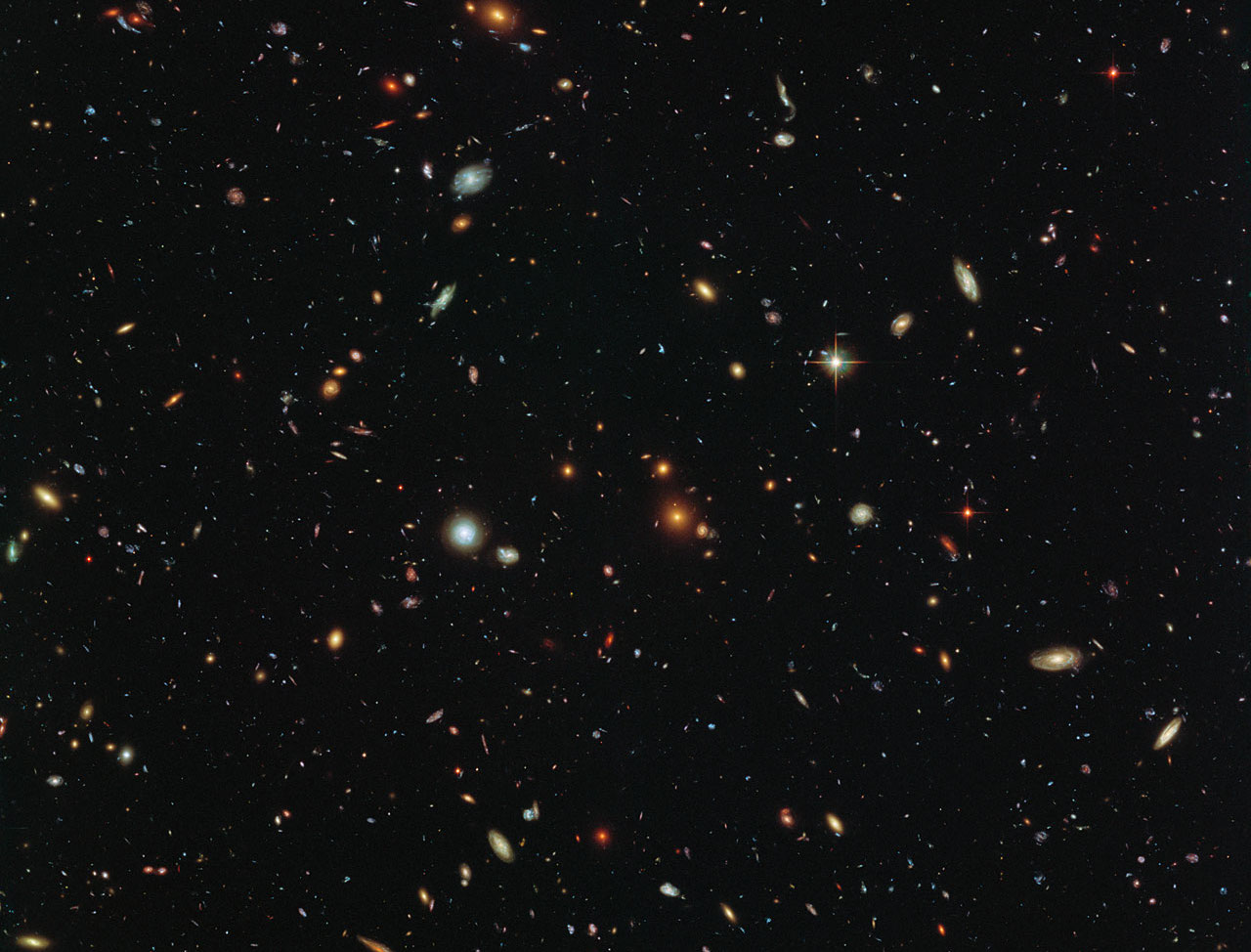A Theoretical Physicist Dives Into Black Holes
Priyamvada Natarajan tells why she fell for black holes, how they shape galaxies, and her favorite fictional depictions of them.
Lurking at the center of nearly every galaxy, there is a hungry black hole.
Some can grow millions to billions times larger than the mass of our sun. Their strong gravitational field allows them to engulf nearby planets, gas, and stars. Not even the speed of light can escape the intense pull of the membrane of a black hole, or event horizon — what researchers often refer to as the point of no return.

Despite their abundance and looming presence in the universe, these massive, majestic objects remain a bottomless mystery to astrophysicists.
“They’re the most enigmatic objects in the universe,” Priyamvada Natarajan, a theoretical astrophysicist at Yale University, told Science Friday in a previous interview. “They’re crazy cool objects given what they do to light, what they do to matter around them, and so on … They are the strangest objects.”
[LIGO scientists detect another cosmic collision.]
These elusive qualities are what lures Natarajan into the deep end of black hole and dark matter research. Science Friday caught up with Natarajan to ask her about why she fell for black holes, how they shape galaxies, her favorite depictions of them on TV and film, applying philosophy to astronomical questions, and how they can dance the tango.
How did you become interested in studying black holes?
I have always been in awe of the mysterious and enigmatic. The sense of mystery coupled with a lack of total comprehension has attracted me to study elusive phenomena in the universe. What seems just a tiny bit out of reach in terms of being abstract and hard to fathom beckons. In fact, this is an utterly human instinct; we are all curious about black holes because they are so extraordinary.
“I have always been in awe of the mysterious and enigmatic.”
Black holes have this bizarre region called the event horizon that appears to mark the boundary between the knowable and unknowable, which I find personally very intriguing. Black holes and dark matter — the two key research areas that I work on — are tantalizing in very similar ways to me: We have many lines of independent evidence revealing their existence indirectly (as they cannot be mapped directly), yet their true nature remains elusive at the moment. It’s just the kind of challenge that draws me in.
Why are black holes piquing so much interest among researchers and the public?
Over the past 50 years, black holes have transitioned from being an exotic mathematical curiosity, a solution to a complex equation, to classes of real astronomical objects whose presence can be inferred indirectly. As per our rapidly evolving current understanding, black holes have actually moved from being marginal to playing a pivotal role in modulating the assembly of stars in galaxies that populate the universe.
Black holes have had a major resurgence in terms of research due to a grand convergence in our theoretical understanding, the wealth of observational data and sophistication of computational methods available to model them. This alignment of the various approaches to scientifically understand black holes has been in motion for the past two decades or so. Of course, the recent spectacular discovery of gravitational waves from colliding black holes reported by the LIGO collaboration has been emblematic of this convergence. There is a lot of new exciting data on black holes that we are currently gathering on nearby dormant supermassive black holes lurking at the centers of galaxies, on distant actively feeding black holes shining as quasars, and, of course, on the black hole hosted at the center of our own galaxy.
[Roger Penrose reflects on the moment black holes went mainstream.]
As for interest amongst the curious public, black holes have always had a hold on the popular imagination given their bizarre properties, primary amongst which is that they are extreme objects that signify a point of no return even for light!
In an earlier Science Friday interview about the detection of the third gravitational wave, you compare the merging of black holes to a kind of “tango.” Why is the phenomenon like a dance?
The process of two black holes merging is initially a slow dance that picks up in intensity like a tango. They start out captured in the grip of their mutual gravitational attraction as a bound pair and start to orbit around each other. After which, they are progressively drawn closer and closer in toward each other to a critical distance at which point the distortions in space-time generated from the shrinking distance are so extreme that the first tremors in space-time — gravitational waves — start to be produced.

As the first cascade of waves is emitted, it signifies that the angular momentum or rotation in their orbit is starting to become efficiently discarded, getting them to a closer embrace and ultimately enabling them to collide head on.
In many films, black holes are portrayed as something monstrous and scary. Why did they gain this reputation? Do you think this image is changing?
Even before the scientific idea of a black hole was discovered, the term “black hole” was in use in the public sphere. It has a macabre history. The origin of the term can be traced back to a dungeon in Calcutta, India, where on June 20, 1756, captured soldiers were imprisoned and died overnight. This horrific prison, a point of no return, was designated as a black hole. Strangely, of course, this turns out to be an apt and accurate definition for astrophysical black holes. Unsurprisingly, the term black hole stood for horror. (If you’re curious about the origin of the term and its various uses in fiction and pop culture, check out my most recent book Mapping the Heavens: The Radical Scientific Ideas that Reveal the Cosmos).
“Black holes have actually moved from being marginal to playing a pivotal role in modulating the assembly of stars in galaxies that populate the universe.”
Their invisibility coupled with their peculiar properties have fired the imagination of filmmakers and novelists. Christopher Nolan’s recent movie, Interstellar, actually goes well beyond simply portraying black holes as monstrous and scary. In this film, space explorers harness the immense gravity of the supermassive black hole Gargantua, to propel them to newer more distant worlds. This is definitely an example of how the bizarre properties of black holes have been deployed in a constructive and ingenious fashion.
But, most often than not, black holes have been used for scare-mongering and to depict unimaginable horror, rather successfully I might add. For example, another instance where black holes have been employed imaginatively is in my favorite anime series, Rumiko Takahashi’s manga, Inuyasha. Here, the hand of the protagonist, Miroku, is cursed by his ancestors, and transmutes into a black hole — a wind tunnel — that destroys anything and everything it encounters. This of course carries the risk of swallowing Miroku himself!
[Researchers trace light to map the cosmic darkness.]
You use the bending of light to study black holes. Why are they so difficult to visualize?
Due to the immense gravity of black holes, they impact the paths of light rays that stray close. If light rays get perilously close to or penetrate the event horizon they will be halted completely by the black hole. However, if they just skirt close at a distance referred to as the photon radius (located outside the event horizon), they will be bent around by the gravity of the black hole. The bending is so extreme that it would correspond to us being able to see the backside of the black hole. It is hard to both calculate this strong bending that would be produced in a bundle of light rays and to depict it visually. This was rendered accurately and visualized beautifully in Interstellar.

This is a variant of the accretion disk of the black hole Gargantua seen in Interstellar designed by Double Negative Visual Effects, which worked on the film. Credit: Double Negative Visual Effects/© Warner Bros. Entertainment Inc./CC BY-NC-ND 3.0
What can the nature and dynamics of black holes tell us about our universe?
The nature and dynamics of black holes tell us a lot of about the role they play in the modulation of galaxy formation. Active black holes, quasars, that are rendered visible due to the glowing in falling gas, are likely to play a starring role in controlling the formation of stars in a galaxy.
Quasars, the lighthouses of the universe, can be detected out to the farthest reaches of the universe, and might reveal when the first structures lit up in the universe. While black holes do not significantly contribute to the overall mass inventory of the universe, the energy produced by the dying gasps of gas and stars that are falling into black holes are substantial. The detection of gravitational waves from merging black holes has proved that our conceptual understanding and the framework that we have developed to study the universe and its contents — Einstein’s theory of general relativity — stands validated.
[Celebrating 100 years of general relativity.]
Now, of course as scientists it is our quest to push the precision of our current measurements and see if this theory still works when we have better and better quality data. It would be exciting if some new cracks appear in the theory and some observational anomalies show up. This is often how the door opens for a brand new theory that offers a more comprehensive explanation. On the other hand, it may turn out that Einstein’s theory of general relativity continues to provide an accurate description of the data and our universe.
What are some of the biggest misunderstanding about black holes?
Not quite sure what the misunderstanding are, but there are definitely awkward questions — awkward since we don’t have scientific answers for them yet. Some popular ones: What really happens to matter and light when they cross the event horizon? What happens to their energy and information? And if the singularity is really a rip in space-time where does it lead to? A wormhole to another universe?
These are questions that are at the cutting edge of scientific investigation and they are active areas of research. Hopefully these will become questions we can actually answer rather than merely speculate about in the coming years.
[Astronomers play hide-and-seek with supermassive black holes.]
You have also spent part of your academic career studying philosophy. How does it affect your understanding and approach to your astrophysics research?

I started out doing a doctorate in the history and philosophy of science at the program in Science, Technology and Society (STS) at Massachusetts Institute of Technology, where I had been an undergrad. I wanted to be a new kind of intellectually engaged scientist, someone who would work at the frontier in astrophysics and yet also think more deeply and broadly about the ideas that informed my scientific work. I was always interested in the process of science as well as the content of science. So in my youth, I thought I needed two Ph.D.s, one in STS and one in astrophysics. After doing my coursework, in STS and learning to read and write (as opposed to calculating … this is alluding to a classic MIT-Harvard joke of a student with a cartful of groceries at the five items only checkout counter of the local Stop & Shop), qualifying for the Ph.D., my plan was to then start the astrophysics Ph.D., finish it and then come back and finish up the STS one. Well, life is strange and magical, I ended up finishing my Ph.D. at the Institute of Astronomy in Cambridge (U.K.) and my astrophysics research and career took off so I never looked back. I am still ABD (all but dissertation) at MIT STS!
“Straddling these two different worldviews has allowed me to practice assessing and evaluating ideas simultaneously as an insider and an outsider.”
However, what that graduate training in the humanities has given me is a more nuanced understanding of how science works. Also, it has inevitably shaped how I approach problems in my scientific research. The more profound effect though has been its impact on my personal intellectual quest — I am in search of both a broad and deep understanding of everything I work on, and this interdisciplinary exposure has helped build my strength and expertise in a particular flavor of work that is marked by synthesis of ideas that initially appear to be disparate and disconnected.
Straddling these two different worldviews has allowed me to practice assessing and evaluating ideas simultaneously as an insider and an outsider. The stint at MIT STS also helped me become a much better writer. I have always wanted to write for the curious public as well as for my colleagues in science.
What other mysteries would still like to solve about black holes?
For me personally, the most exciting question at the moment is regarding the origin of the first black holes. These are the so-called “seed black holes” that eventually grew to be the supermassive black holes that now appear to reside in the center of almost every galaxy including our own.
About a decade ago, in a series of papers, we proposed that there could be an alternate pathway to make these initial seed black holes. We argued that besides the death of the first stars, the available conditions in the early universe would permit the formation of an entirely new class of more massive black hole seeds. This new channel would make direct collapse black hole seeds, that would be rarer but extremely massive (about 10,000 – 100,000 times the mass of our sun) from the get-go.
[Physicists unravel mysteries of black holes.]
Massive early seeds come in extremely handy to explain the ultramassive black holes (with masses in excess of a few billion solar masses) that seem to power the most distant and brightest quasars detected in the very early universe, rather uncomfortably soon after the Big Bang. Making massive black hole seeds rapidly in the very early universe enables us to explain the assembly history of the most massive black holes detected today as it is a key piece of the black hole growth puzzle. This idea of massive black hole seeds stands to be tested by the upcoming satellite mission, the James Webb Space Telescope, which is scheduled to be launched next year. There are very specific predictions of what the instruments aboard James Webb ought to see.
It would be awesome if signatures of these seeds are detected. It would of course be thrilling if direct collapse black holes were detected, which would validate the idea but it would still be exciting if it was conclusively disproved. Never before in history could new ideas be tested so rapidly. It is so much fun to be doing science in this fast paced epoch when within a lifetime new ideas can be assessed and accepted or rejected.
What gets you excited about the future of cosmology and astrophysics research?
Research into the fundamental questions in cosmology that is salient to our understanding of this universe and how we got here is what I find exciting. As I mentioned, it is a rather special time in cosmology as the sophistication of our ideas and instruments have finally aligned and this is enabling an accelerated pace of discoveries. The wealth of data that we currently have and that is expected soon from a plethora of new observatories and instruments on the ground and in space offer new tests of our theories. The thrill lies in not knowing what we might uncover.
Who knows what awaits. I constantly remind myself that just a 100 years ago we did not know of the existence of other galaxies. Our cosmic view was limited to just the Milky Way. Maybe we will uncover credible evidence for the existence of other universes in the next 100 years! Before that, I think we will likely discover that we are not alone in the universe, perhaps not another intelligent civilization quite like our own but definitely some form of life elsewhere. I just feel so grateful and lucky to be alive now and to have the privilege to be engaged in science.
Correction, August 21, 2017: An earlier version of this article stated that the the date of the imprisonment of soldiers at the black hole of Calcutta was June 20, 1956. The correct date is June 20, 1756.
Lauren J. Young was Science Friday’s digital producer. When she’s not shelving books as a library assistant, she’s adding to her impressive Pez dispenser collection.